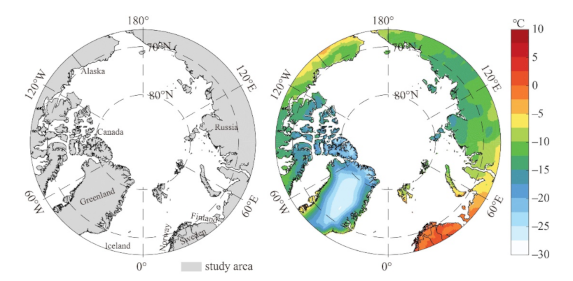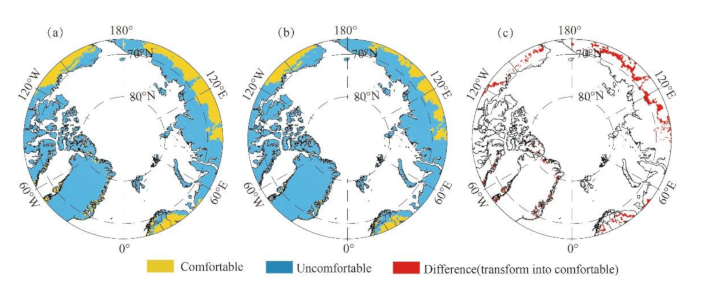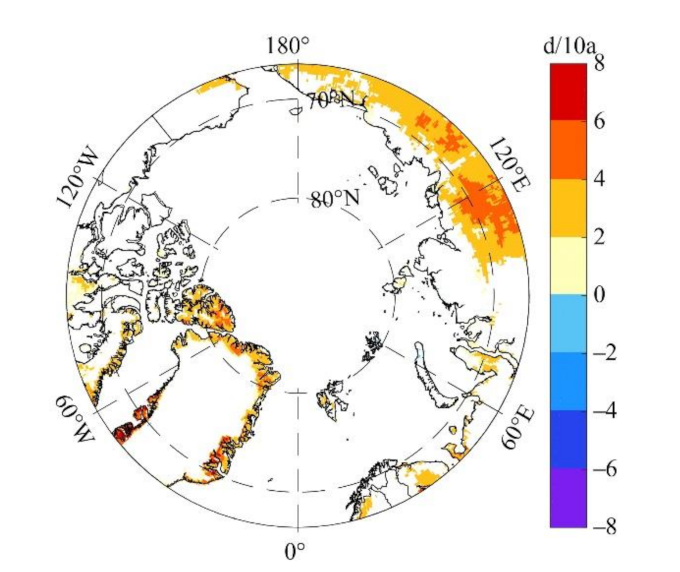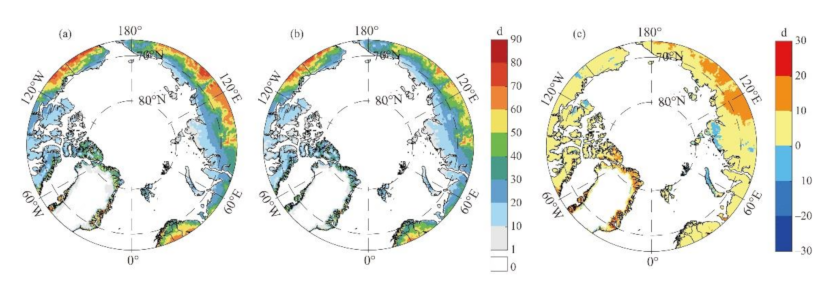Spatial-Temporal Characteristics of Arctic Summer Climate Comfort Level in the Context of Regional Tourism Resources from 1979 to 2019
Abstract
1. Introduction
2. Materials and Methods
2.1. Study Area
2.2. Datasets
2.3. Methods
2.3.1. Trend Analysis Method
2.3.2. Rescaled Adjusted Partial SUMS (RAPS) Method
2.3.3. Correlation Analysis
3. Results
3.1. Change of UTCI in the Arctic Summer (1979–2019)
3.2. Change in the Area Rated “Comfortable” in the Arctic Summer
3.3. Change in the Number of Arctic Summer Comfortable Days from 1979 to 2019
4. Discussion
5. Conclusions
Author Contributions
Funding
Institutional Review Board Statement
Informed Consent Statement
Data Availability Statement
Acknowledgments
Conflicts of Interest
References
- IPCC. 2021: Summary for Policymakers. In Climate Change 2021: The Physical Science Basis. Contribution of Working Group I to the Sixth Assessment Report of the Intergovernmental Panel on Climate Change; Cambridge University Press: Cambridg, UK, 2021. [Google Scholar]
- Chen, L.Q. Evidence of Arctic and Antarctic changes and their regulation of global climate change (further findings since the fourth IPCC assessment report released). Adv. Polar Sci. 2013, 25, 1–6. (In Chinese) [Google Scholar] [CrossRef]
- Semenza, J.C.; Ebi, K.L. Climate change impact on migration, travel, travel destinations and the tourism industry. J. Travel Med. 2019, 26, 1–13. [Google Scholar] [CrossRef]
- Lise, W.; Tol, R.S.J. Impact of climate on tourist demand. Clim. Chang. 2002, 55, 429–449. [Google Scholar] [CrossRef]
- Hall, C.M.; Saarinen, J. Polar Tourism: Definitions and Dimensions. Scand. J. Hosp. Tour. 2010, 10, 448–467. [Google Scholar] [CrossRef]
- Hansen, B.B.; Isaksen, K.; Benestad, R.E.; Kohler, J.; Pedersen, A.Ø.; Loe, L.E.; Coulson, S.J.; Larsen, J.O.; Varpe, Ø. Warmer and wetter winters: Characteristics and implications of an extreme weather event in the High Arctic. Environ. Res. Lett. 2014, 9, 114021. [Google Scholar] [CrossRef]
- Hall, C.M.; Baird, T.; James, M.; Ram, Y. Climate change and cultural heritage: Conservation and heritage tourism in the Anthropocene. J. Herit. Tour. 2016, 11, 10–24. [Google Scholar] [CrossRef]
- Scott, D.; Wall, G.; McBoyle, G. Chapter 7. Climate Change and Tourism and Recreation in North America: Exploring Regional Risks and Opportunities. In Tourism, Recreation and Climate Change; Hall, C.M., Higham, J., Eds.; Channel View Publications: Blue Ridge Summit, PA, USA; Bristol, UK, 2005; Volume 22, pp. 115–129. [Google Scholar] [CrossRef]
- Yu, W.Y.; Wang, L.; Feng, Z.G.; Zhang, C.Y. Bibliometric analysis and development trends of global Arctic marine scientific research. Mar. Sci. 2018, 42, 64–81. (In Chinese) [Google Scholar]
- Notz, D.; Stroeve, J. Observed Arctic sea-ice loss directly follows anthropogenic CO2 emission. Science 2016, 354, 747–750. [Google Scholar] [CrossRef]
- Fay, G.; Karlsdóttir, A. Social indicators for arctic tourism: Observing trends and assessing data. Polar Geogr. 2011, 34, 63–86. [Google Scholar] [CrossRef]
- Suzanne, D.L.B.; Maher, P.; Dawson, J.; Hillmer-Pegram, K.; Huijbens, E.; Lamers, M.; Liggett, D.; Müller, D.; Pashkevich, A.; Stewart, E. Tourism and Arctic Observation Systems: Exploring the relationships. Polar Res. 2016, 35, 24980. [Google Scholar] [CrossRef]
- Stephen, K. Societal Impacts of a Rapidly Changing Arctic. Curr. Clim. Chang. Rep. 2018, 4, 223–237. [Google Scholar] [CrossRef]
- Forland, E.J.; Jacobsen, J.; Denstadli, J.M.; Lohmann, M.; Hanssen-Bauer, I.; Hygen, H.O.; Tommervik, H. Cool weather tourism under global warming: Comparing arctic summer tourists’ weather preferences with regional climate statistics and projections. Tour. Manag. 2013, 36, 567–579. [Google Scholar] [CrossRef]
- Roshan, G.; Yousefi, R.; Kovacs, A.; Matzarakis, A. A comprehensive analysis of physiologically equivalent temperature changes of Iranian selected stations for the last half century. Theor. Appl. Climatol. 2018, 131, 19–41. [Google Scholar] [CrossRef]
- Roshan, G.; Yousefi, R.; Błażejczyk, K. Assessment of the climatic potential for tourism in Iran through biometeorology clustering. Int. J. Biometeorol. 2017, 62, 525–542. [Google Scholar] [CrossRef] [PubMed]
- Eludoyin, O.; Adelekan, I.; Webster, R.; Eludoyin, A. Air temperature, relative humidity, climate regionalization and thermal comfort of Nigeria. Int. J. Climatol. 2014, 34, 2000–2018. [Google Scholar] [CrossRef]
- Feng, L.; Liu, Y.X.; Feng, Z.Z.; Yang, S.Q. Analysing the spatiotemporal characteristics of climate comfort in China based on 2005–2018 MODIS data. Theor. Appl. Climatol. 2021, 143, 1235–1249. [Google Scholar] [CrossRef]
- Wu, F.F.; Yang, X.H.; Shen, Z.Y.; Yi, Z.J. Long-term trends and spatiotemporal variations of climate comfort in China during 1966–2016. Therm. Sci. 2020, 24, 2445–2453. [Google Scholar] [CrossRef]
- Yu, G.; Schwartz, Z.; Walsh, S. Effects of climate change on the seasonality of weather for tourism in Alaska. Arctic 2009, 62, 443–457. [Google Scholar] [CrossRef]
- Yu, Z.K.; Sun, G.N.; Feng, Q.; Luo, Z.W. Spatiotemporal dynamic analysis of tourism climate comfort and climate risk in the Tibetan Plateau. Resour. Sci. 2014, 36, 2327–2336. (In Chinese) [Google Scholar]
- Jin, A.Q.; Zhang, A.; Zhao, X.Y. Prediction of future climate comfort in eastern China under climate change scenario. Acta Sci. Nat. Univ. Pekin. 2019, 55, 887–898. (In Chinese) [Google Scholar]
- Shi, L.; Huang, X.Q.; Ni, M.J.; Ci, R.Y.Z.; Luo, Z. Analysis on the adaptability of tourism climate in Tibet Autonomous Region. J. Glaciol. Geocryol. 2015, 37, 1412–1419. (In Chinese) [Google Scholar]
- Sun, Y.C.; Wang, S.Y.; Li, H.; Zheng, G.F.; Wang, F.; Guan, J.D. Climate comfort analysis of summer tourism in Liu Pan Mountain Area of Ningxia. J. Arid Meteorol. 2018, 36, 1035–1042. (In Chinese) [Google Scholar]
- Zeng, D.; Wu, J.; Mu, Y. Spatial-Temporal Pattern Changes of UTCI in the China-Pakistan Economic Corridor in Recent 40 Years. Atmosphere 2020, 11, 858. [Google Scholar] [CrossRef]
- Scott, D.; Mcboyle, G.; Schwartzentruber, M. Climate change and the distribution of climatic resources for tourism in North America. Clim. Res. 2004, 27, 105–117. [Google Scholar] [CrossRef]
- Napoli, C.; Pappenberger, F.; Cloke, H. Assessing heat-related health risk in Europe via the Universal Thermal Climate Index (UTCI). Int. J. Biometeorol. 2018, 62, 1155. [Google Scholar] [CrossRef] [PubMed]
- Basarin, B.; Luki, T.; Matzarakis, A. Review of Biometeorology of Heatwaves and Warm Extremes in Europe. Atmosphere 2020, 11, 1276. [Google Scholar] [CrossRef]
- Basarin, B.; Lukic, T.; Matzarakis, A. Quantification and assessment of heat and cold waves in Novi Sad, Northern Serbia. Int. J. Biometeorol. 2016, 60, 139–150. [Google Scholar] [CrossRef]
- Nastos, P.T.; Matzarakis, A. The effect of air temperature and human thermal indices on mortality in Athens, Greece. Theor. Appl. Climatol. 2012, 108, 591–599. [Google Scholar] [CrossRef]
- Bleta, A.; Nastos, P.T.; Matzarakis, A. Assessment of bioclimatic conditions on Crete Island, Greece. Reg. Environ. Chang. 2014, 14, 1967–1981. [Google Scholar] [CrossRef]
- Katavoutas, G.; Founda, D. Response of Urban Heat Stress to Heat Waves in Athens (1960–2017). Atmosphere 2019, 10, 483. [Google Scholar] [CrossRef]
- Katavoutas, G.; Founda, D. Intensification of thermal risk in Mediterranean climates: Evidence from the comparison of rational and simple indices. Int. J. Biometeorol. 2019, 63, 1251–1264. [Google Scholar] [CrossRef]
- Pecelj, M.M.; Luki´c, M.Z.; Filipovi´c, D.J.; Proti´c, B.M. Summer variation of the UTCI index and Heat Waves in Serbia. Nat. Hazards Earth Syst. Sci. 2019, 1–19. [Google Scholar] [CrossRef]
- Rasilla, D.; Allende, F.; Martilli, A.; Fernández, F. Heat Waves and Human Well-Being in Madrid (Spain). Atmosphere 2019, 10, 288. [Google Scholar] [CrossRef]
- Wereski, S.; Krzyżewska, A.; Dobek, M. Winter UTCI variability in Poland in the 21st century. Reg. Stud. Dev. 2020, 24, 128–137. [Google Scholar] [CrossRef]
- Hamilton, J.M.; Tol, R. The impact of climate change on tourism in Germany, the UK and Ireland: A simulation study. Reg. Environ. Chang. 2007, 7, 161–172. [Google Scholar] [CrossRef]
- Nicholls, S.; Amelung, B. Implications of climate change for rural tourism in the nordic region. Scand. J. Hosp. Tour. 2015, 15, 48–72. [Google Scholar] [CrossRef]
- Nicholls, S.; Amelung, B. Climate change and tourism in northwestern europe: Impacts and adaptation. Tour. Anal. 2008, 13, 21–31. [Google Scholar] [CrossRef]
- Li, S.; Sun, M.S.; Zhang, W.J.; Tan, L.; Zhu, N.N.; Wang, Y.F. Spatial pattern and evolution of climatic comfort period in mainland China from 1961 to 2010. Geogr. Res. 2016, 35, 2053–2070. (In Chinese) [Google Scholar]
- Zhong, L.S.; Yu, H.; Zeng, Y.X. Impact of climate change on Tibet tourism based on tourism climate index. J. Geogr. Sci. 2019, 29, 2085–2100. [Google Scholar] [CrossRef]
- Haldane, J. The Influence of High Air Temperatures No. I. Epidemiol. Infect. 1905, 5, 494–513. [Google Scholar] [CrossRef]
- Hill, L.; Griffith, O.W.; Flack, M. The measurement of the rate of heat loss at body temperature by convection, radiation and evaporation. Philos. Trans. R. Soc. 1916, 207, 225–347. [Google Scholar] [CrossRef]
- Yaglou, C.P.; Minard, D. Control of heat casualties at military training centers. Am. Med. Assoc. Arch. Ind. Health 1957, 16, 302–316. [Google Scholar]
- Thorn, E.C. The discomfort index. Weathenvise 1959, 12, 57–60. [Google Scholar]
- Houghton, F.C.; Yaglou, C.P. Determining equal comfort lines. J. Am. Soc. Heat. Vent. Eng. 1923, 29, 165–176. [Google Scholar]
- Siple, P.; Passel, C.F. Measurements of dry atmospheric cooling in subfreezing temperature. Proc. Am. Philos. Soc. 1945, 89, 177–199. [Google Scholar] [CrossRef]
- Fanger, P.O. Thermal comfort: Analysis and applications in environmental engineering. In Thermal Comfort Analysis & Applications in Environmental Engineering; Danish Technical Press: Copenhagen, Denmark, 1970; pp. 225–240. [Google Scholar]
- McArdle, B.; Dunham, W.; Holling, H.E.; Ladell, W.S.S.; Scott, J.W.; Thomson, M.L.; Weiner, J.S.; Holing, H. The prediction of the physiological effects of warm and hot Environments. In Renewable Northwest Project Report; Medical Resource Council: London, UK, 1947; pp. 47–391. [Google Scholar]
- Hoeppe, P. Die Energiebilanz des Menschen; Muenchen Univ. Press: München, Germany, 1984. [Google Scholar]
- Blazejczyk, K.; Epstein, Y.; Jendritzky, G.; Staiger, H.; Tinz, B. Comparison of UTCI to selected thermal indices. Int. J. Biometeorol. 2012, 56, 515–535. [Google Scholar] [CrossRef]
- Jendritzky, G.; De, D.R.; Havenith, G. UTCI-why another thermal index? Int. J. Biometeorol. 2012, 56, 421–428. [Google Scholar] [CrossRef] [PubMed]
- Brode, P.; Fiala, D.; Blazejczyk, K.; Holmer, I.; Jendritzky, G.; Kampmann, B.; Tinz, B.; Havenith, G. Deriving the operational procedure for the Universal Thermal Climate Index (UTCI). Int. J. Biometeorol. 2012, 56, 481–494. [Google Scholar] [CrossRef]
- Kong, Q.Q.; Zheng, J.Y.; Wang, X.G. Spatial pattern and temporal variation in thermal comfort in China from 1979 to 2014. Resour. Sci. 2016, 38, 1129–1139. (In Chinese) [Google Scholar]
- Zhang, X.Y.; Jiang, C.; Sun, J.X.; Zhou, M.F. Spatiotemporal variation characteristics and influencing factors of climate comfort at different altitudes. Chin. J. Appl. Ecol. 2018, 29, 2808–2818. (In Chinese) [Google Scholar]
- Hoyt, D.V. Percent of possible sunshine and the total cloud cover. Mon. Weather Rev. 1977, 105, 648–652. [Google Scholar] [CrossRef][Green Version]
- Garbrecht, J.; Fernandez, G.P. Visualization of trends and fluctuations in climatic records1. J. Am. Water Resour. Assoc. 2010, 30, 297–306. [Google Scholar] [CrossRef]
- Vinogradova, V. Using the Universal Thermal Climate Index (UTCI) for the assessment of bioclimatic conditions in Russia. Int. J. Biometeorol. 2021, 65, 1473–1483. [Google Scholar] [CrossRef] [PubMed]
- Zhang, D.; Wang, M.; Gan, M.Y.; Yang, L.S. Research progress on influencing factors of Arctic tourism. Resour. Sci. 2021, 43, 1687–1699. [Google Scholar] [CrossRef]
- Lan, C.Z. Polar tourism: High-end tourism and sustainable development under unique resource conditions. World Environ. 2017, 3, 70–73. (In Chinese) [Google Scholar]
- Luo, M.; Guo, Y.A. Legal dilemma and solution for the development of tourism resources in the Arctic region. Chin. J. Marit. Law 2020, 31, 58–66. (In Chinese) [Google Scholar]










| UTCI (°C) | Stress Category | Comfort Level | UTCI (°C) | Stress Category | Comfort Level |
|---|---|---|---|---|---|
| >46 | Extreme heat stress | Extreme hot | 0~9 | Slight cold stress | Cool |
| 38~46 | Very strong heat stress | Very hot | −13~0 | Moderate cold stress | Colder |
| 32~38 | Strong heat stress | Hot | −27~−13 | Strong cold stress | Cold |
| 26~32 | Moderate heat stress | Hotter | −40~−27 | Very strong cold stress | Very cold |
| 9~26 | No thermal stress | Comfort | <−40 | Extreme cold stress | Extreme cold |
| (105 km2) | 0–10 d | 11–20 d | 21–30 d | 31–40 d | 41–50 d | 51–60 d | 61–70 d | 71–80 d | 81–92 d |
|---|---|---|---|---|---|---|---|---|---|
| 2010–2019 | 9.74 | 12.79 | 11.90 | 9.57 | 8.07 | 8.93 | 6.66 | 1.67 | 0.04 |
| 1979–1988 | 12.70 | 15.13 | 12.12 | 9.54 | 9.05 | 7.02 | 2.09 | 0.64 | 0.00 |
| Difference | −2.96 | −2.34 | −0.22 | 0.03 | −0.98 | 1.91 | 4.57 | 1.03 | 0.04 |
| Temperature | Relative Humidity | Wind Speeds | TCC | |
|---|---|---|---|---|
| Comfortable Area | 0.818 ** | 0.07 | −0.218 | −0.340 * |
| Comfortable Days | 0.944 ** | 0.086 | −0.309 | −0.514 ** |
Publisher’s Note: MDPI stays neutral with regard to jurisdictional claims in published maps and institutional affiliations. |
© 2021 by the authors. Licensee MDPI, Basel, Switzerland. This article is an open access article distributed under the terms and conditions of the Creative Commons Attribution (CC BY) license (https://creativecommons.org/licenses/by/4.0/).
Share and Cite
Huang, Y.; Zhang, X.; Zhang, D.; Zhang, L.; Zhang, W.; Ren, C.; Pan, T.; Chu, Z.; Chen, Y. Spatial-Temporal Characteristics of Arctic Summer Climate Comfort Level in the Context of Regional Tourism Resources from 1979 to 2019. Sustainability 2021, 13, 13056. https://doi.org/10.3390/su132313056
Huang Y, Zhang X, Zhang D, Zhang L, Zhang W, Ren C, Pan T, Chu Z, Chen Y. Spatial-Temporal Characteristics of Arctic Summer Climate Comfort Level in the Context of Regional Tourism Resources from 1979 to 2019. Sustainability. 2021; 13(23):13056. https://doi.org/10.3390/su132313056
Chicago/Turabian StyleHuang, Yutao, Xuezhen Zhang, Dan Zhang, Lijuan Zhang, Wenshuai Zhang, Chong Ren, Tao Pan, Zheng Chu, and Yuying Chen. 2021. "Spatial-Temporal Characteristics of Arctic Summer Climate Comfort Level in the Context of Regional Tourism Resources from 1979 to 2019" Sustainability 13, no. 23: 13056. https://doi.org/10.3390/su132313056
APA StyleHuang, Y., Zhang, X., Zhang, D., Zhang, L., Zhang, W., Ren, C., Pan, T., Chu, Z., & Chen, Y. (2021). Spatial-Temporal Characteristics of Arctic Summer Climate Comfort Level in the Context of Regional Tourism Resources from 1979 to 2019. Sustainability, 13(23), 13056. https://doi.org/10.3390/su132313056






